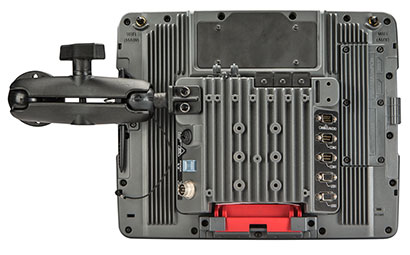The Thor VM3, introduced by Honeywell in March 2015, is a full-size vehicle-mount computer with a 12.1-inch XGA touch display and a number of multi-function keys. Depending on the intended application, the Intel Bay Trail-powered Thor can be operated with either standard or embedded versions of full Windows or with the small footprint Windows Embedded Compact 7. The VM3, the latest in a long sequence of vehicle-mount computer generation, is a close cousin to the company's Thor VM1 and VM2, but without an integrated keyboard and with a larger display.

The Thor VM3 has a footprint of 12.5 x 10.3 inches, is about 2.5 inches thick, and weighs under seven pounds. The VM3's display measures 12.1 inches diagonally. The display is available with either resistive touch, industrial resisitive touch with a defroster for use in cold climates, and also with projected capacitive multi-touch. A unique feature here is that the VM3's most damage-prone components, primarily the front panel, are user-replaceable on the go.
The VM3 is powered by a dual-core 1.5GHz Intel Atom E3826 processor that part of Intel's "Bay Trail" lineup of vastly improved Atom CPUs that are powerful enough to not only be sold under the Atom brand, but also the Celeron and Pentium brands. The E3826 actually uses the same GPU architecture as in Intel's 3rd generation ("Ivy Bridge") Core processors, just with fewer execution units. What that means is that the VM3 offers substantially higher performance (likely in the 3X range) than the Intel Atom Z530-based Thor VM2.
The ability to run certain applications often determines the purchase decision of vehicle-mount computers. Since some of that software was written for Windows CE and some for standard Windows, the Thor VM3 can run both the Windows CE-derived Windows Embedded Compact 7 or various versions of standard Windows. Depending on the choice of operating system, Thor devices are equipped with 2GB of RAM for Windows WEC7, or with 32 or 64GB of solid state storage for full Windows versions.

As far as ruggedness goes, the Thor VM3 was designed to handle the typical conditions encountered in vehicle use. The device is sealed to IP66 specifications, which means it is totally protected against dust and it can also handle strong jets of water from all directions. The Thor is also vibration-proof and can operate in a very wide temperature range of -22 to 122 degrees Fahrenheit. For use in very low temperatures, customers can even order a screen defroster. As the pictures below and in the sidebar show, the Thor VM3 can be mounted virtually anywhere and in numerous ways.
The designers of the Thor line of vehicle-mount panel computers know that some applications only need touch whereas others need, or benefit from, a keyboard or keypad. The VM2 is for the former, whereas the mechanically almost identical Thor VM1 covers the latter. Both the Thor VM2 and VM1 are compatible with the line's quick-mount smart dock.

The Thor VM3 generally uses vehicle power (10 to 60VDC), but Honeywell also offers external converters for AC or extended VDC (60 to 150V). And since the VM3 is designed to work with a quick-mount smart dock, it also has an internal bridge battery that provides power for up to 30 minutes even in very cold weather. That way it can be moved to a different vehicle or location without shut-down, or even operated while walking around for brief periods of time.
Wireless communication capabilities are becoming ever more important in vehicle-mounted computers, and so the Thor includes not only the usual WiFi and Bluetooth, but customers can also order an internal 4G WWAN module for wireless data (but not voice). And there's also assisted GPS.
"Thor" being the name of a hammer-wielding nordic god, the naming likely plays homage to the former LXE's Akerstroms Trux connection (LXE bought Akerstroms Trux in 2008, Honeywell bought LXE in 2011) which was already used for the company's Förj and Kärv vehicle-mount tablets. Good pedigree indeed.









